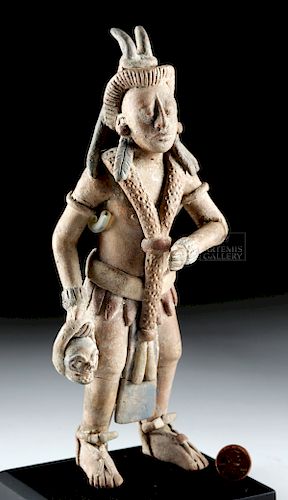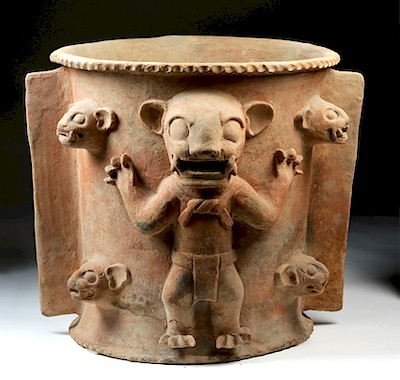Maya Jaina Pottery Standing Figure with Skull
Lot 93d
About Seller
Artemis Fine Arts
686 S Taylor Ave, Ste 106
Louisville, CO 80027
United States
Selling antiquities, ancient and ethnographic art online since 1993, Artemis Gallery specializes in Classical Antiquities (Egyptian, Greek, Roman, Near Eastern), Asian, Pre-Columbian, African / Tribal / Oceanographic art. Our extensive inventory includes pottery, stone, metal, wood, glass and textil...Read more
Estimate:
$3,000 - $4,500
Absentee vs Live bid
Two ways to bid:
- Leave a max absentee bid and the platform will bid on your behalf up to your maximum bid during the live auction.
- Bid live during the auction and your bids will be submitted real-time to the auctioneer.
Bid Increments
| Price | Bid Increment |
|---|---|
| $0 | $25 |
| $300 | $50 |
| $1,000 | $100 |
| $2,000 | $250 |
| $5,000 | $500 |
| $10,000 | $1,000 |
| $20,000 | $2,500 |
| $50,000 | $5,000 |
| $100,000 | $10,000 |
| $200,000 | $20,000 |
About Auction
By Artemis Fine Arts
Dec 6, 2018
Set Reminder
2018-12-06 10:00:00
2018-12-06 10:00:00
America/New_York
Bidsquare
Bidsquare : DAY 2 : Pre-Columbian, Ethnographic & Fine Art
https://www.bidsquare.com/auctions/artemis-gallery/day-2-pre-columbian-ethnographic-fine-art-3699
Day 2 of an important 2-dy auction featuring ancient and ethnographic art from around the world. Today's sale will feature Pre-Columbian, Native American, African / Tribal, Ethnographic, Spanish Colonial, Fine Art, much more. Artemis Fine Arts info@artemisfinearts.com
Day 2 of an important 2-dy auction featuring ancient and ethnographic art from around the world. Today's sale will feature Pre-Columbian, Native American, African / Tribal, Ethnographic, Spanish Colonial, Fine Art, much more. Artemis Fine Arts info@artemisfinearts.com
- Lot Description
Pre-Columbian, Jaina/Campeche Mexico, Maya, Late Classic Period, ca. 600 to 850 CE. One of my favorites! A fascinating, lifelike ceramic figure, portrayed standing, dressed in dramatic finery and holding a skull by a strap in one hand, like a pre-Columbian Hamlet - although here, this is representative of a trophy head. Trophy heads were a near-universal constant in Mesoamerican imagery for millennia. By the Classic Maya period it seems more likely that the taking of actual trophy heads had (mostly) been replaced by the ball from the ballgame (as in the Popol Vuh, where a decapitated head is used instead of a rubber ball). The figure wears a long, thick necklace held near the waist and below the groin with large beads and terminating in two feathers. Size: 4" W x 9.4" H (10.2 cm x 23.9 cm); 10" H (25.4 cm) on included custom stand.
The figure also wears a dramatic belt with a blue loin cloth that hangs down between the legs. A massive headdress topped by two curved horns sits atop the figure's bald head, and the figure also wears a long feather hanging from a round earring on each ear. Elaborately strapped sandals, armlets, and bracelets complete the figure and provide a fantastic idea for us today of what people in the past wore.
Jaina figures, from an island off the Yucatan peninsula, are noted for their lifelike faces and their immense detail. The clothing that this figure wears almost certainly copies the real clothing of a person in the Late Classic Maya period. These figures probably represent actual people and seem likely to have been produced in Campeche and brought to Jaina Island to be buried with the dead. Fascinatingly, the people around Jaina are the only people in southeastern Mesoamerica who put human figures into graves - everywhere else in the region, figures have only been found in domestic contexts. The use of human figures immediately calls to mind the earlier West Mexican cultures that had extensive figures made solely to be placed in their shaft tombs. The Spaniard Diego de Landa, who recorded details of Maya life shortly after the Spanish Conquest, wrote that the artists who created pieces like this one lived lives of religious isolation and ritual, fasting, and abstaining.
Provenance: private southern California, USA collection, acquired in the 1970s to mid-1980s
All items legal to buy/sell under U.S. Statute covering cultural patrimony Code 2600, CHAPTER 14, and are guaranteed to be as described or your money back.
A Certificate of Authenticity will accompany all winning bids.
We ship worldwide and handle all shipping in-house for your convenience.
#141063Limbs are reattached, as is the head, one part of the headdress, and the bottom of the skirt. Light deposits on surface with excellent remaining detail, including pigment.Condition
- Shipping Info
-
All shipping is handled in-house for your convenience. Your invoice from Artemis Gallery will include shipping calculation instructions. If in doubt, please inquire BEFORE bidding for estimated shipping costs for individual items.
-
- Buyer's Premium



 EUR
EUR CAD
CAD AUD
AUD GBP
GBP MXN
MXN HKD
HKD CNY
CNY MYR
MYR SEK
SEK SGD
SGD CHF
CHF THB
THB











